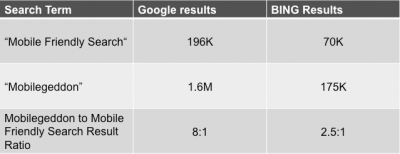A Brand Owner’s Guide to Surviving Mobilegeddon

Congratulations! If you are reading this, it means you have survived the latest doomsday event. And while few people bought into the Mayan prophecy that stated the earth would end in 2012, its legacy lives on today through Google, the omnipresent proselytizer of the digital age.
Google’s latest algorithm update, which came into effect on April 21, 2015 was quickly nicknamed Mobilegeddon. And what better way than to coin an event than through the lens of a biblical battle between good and evil―that will surely scare the hell out of a bunch of marketers. The message is simple. Go mobile or your website risks plummeting in search results.
In essence, the change is Google’s way of nudging organizations of all types to deliver a better mobile experience that reflects the surge of searches done on a smartphone. Not soon after announcing that Google would be “expanding our use of mobile-friendliness as a ranking signal,” the Internet was ablaze with rabble-rousers and fear mongers prophesying that brands whose websites were not optimized for mobile would be wiped off the search grid.
In Google’s defense, the term Mobilegeddon was coined by a search website that appears to subscribe to the Fox News School of Balanced Reporting. Google’s announcement on its own webmaster blog was much more prosaic entitled “Finding more mobile-friendly search results.” Hardly the type of headline to drive the maelstrom that followed.
Still I wouldn’t imagine the folks in Mountain View were protesting too much as others raised the stakes on its behalf.
A quick Google search that paraphrases its own article “Mobile-Friendly Search” and “Mobilegeddon” reveals the power of naming on our behavior and emotions. “Mobilegeddon” has eight-times as many search results than “Mobile Friendly Search”, which demonstrates the stickiness of a big idea. Interestingly, running an identical comparison search on BING (which also powers Yahoo) yields only two and a half-times more searches for Mobilegeddon (see table below).

Table: Search comparison results between Google and BING on day after “Mobilegeddon” (April 22, 2015)
It’s difficult to tell why the ratios between the two search terms differ by search engine so much. Conspiracy lovers (or those of us who have watched too much House of Cards) may enjoy speculating that it would be in Google’s interests to demonstrate more search results that dial up the histrionics, which in turn would drive more to act.

Mobile Friendly or Mobilegeddon?
Conspiracy theories aside, the latest changes should jolt into action many who have been kicking the can down the road. According to a recent Comscore report, “smartphones and tablets combined now account for 60 percent of all online traffic, up from 50 percent a year ago.” With over 177 million active websites, and billions of web pages that are either mobile-friendly or not, Mobilegeddon is the realization that brand marketers cannot ignore mobile as an integral piece of brand expression. What’s brand got to do with it?
Three Major Mobile Implications for Brand Owners:
Your brand guidelines must include mobile
Many brand guidelines include desktop, print, and even digital applications, but mobile can be a different beast altogether. Mobile is not a 1:1 translation. This paring down of desktop content to the essential elements that someone needs to get access to from a smartphone. Designers, copywriters, and developers need to be aware that the immaculate looking splash page that looks great on a desktop translates differently on a smartphone. To avoid these inconsistencies and to ensure proper brand governance, brand guidelines must include in depth guidelines for mobile. Design parameters, content guidelines, webmaster recommendations, and UI/UX development, all need to be adapted for mobile functionality.
Brand governance will become more complex
Many speculated that small companies would be the hardest hit come Mobilegeddon, but numerous Fortune 500 companies were also left exposed. These larger companies often have massive digital footprints, numerous microsites, apps, and an encyclopedia of webpages. Integrating mobile into your brand standards adds significant complexity and another “mole to whack” in the thankless task of maintaining a consistent on-brand experience.
Put in place the right tools to support governance
Guidelines are built to house content, but do you have an effective platform to share and distribute that content so the right people can access it, and to allow you to continually evolve and update. Ensuring you have a flexible online brand asset management system to share your guidelines in its various guises is also key. For example, for mobile, this means having an easy way for developers to access the development pattern library (your brand standards in code form) and for teams to update them and share best practices.
For brand owners with a clear strategy for integrating mobile into the brand process, the latest changes will sound friendly indeed. But if you’re waving your hands in an attempt to get attention, it may be time to consider the nuclear option. For more information, consult the world’s #1 search engine to help build your case.
Gabriel Cohen is Monigle’s Chief Marketing Officer and part-time UFO hunter.
Connect With Us



